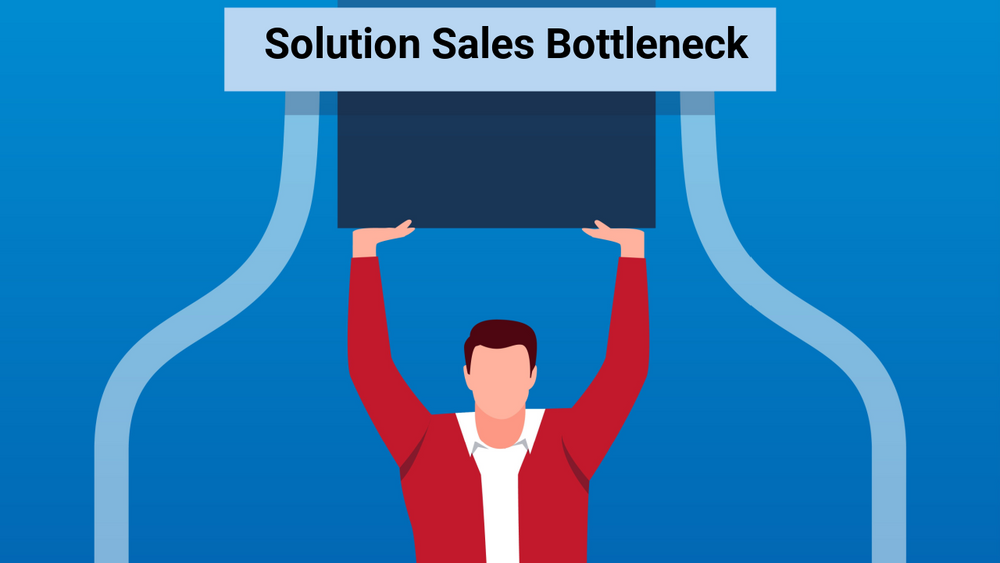The sales bottle-neck in solution-driven enterprises
Solution-driven enterprises quickly recognize an opportunity in the form of a problem or a pain-point in the market, then design and deliver a solution. Every small company typically starts as a solution-driven enterprise. It starts with the promoter(s) having this innovative ability to recognize problems and design solutions.
Business Processs
The processes of a solution-driven enterprise can be represented in the following simple model:
When a business is small, the most capable of the team members (possibly the promoters) are able to carry out the requirements analysis and solution design, while execution, delivery and support can be delegated to team members with lesser skills. With increasing number of success stories with early customers, the business can grow by increasing resources required for execution, delivery and support. However, the functions of requirements analysis and solution design are not easy to scale up.
Conventionally, the function of requirements analysis has been a part of sales. The terminology is borrowed from a product-driven enterprise model, in which marketing, sales, exectution and support can be almost independant functions. In solution-driven enterprises, the sales person does far more than converting leads into orders. The sales person is a partner, helping the customer figure out the needs, and design a solution to meet those needs.
In a small business, the sales is typically restricted to either the most capable of the team members (possibly the promoters) or some sales heroes. These solution-sellers are able to pick up the skills required for requirements analysis and solution design. As long as the heroes are able to handle the demand in the market, the company continues to grow successfully. If all goes well, the demand grows too large to handle. Increasing the sales force with fresh talent can be of limited value. The skills for requirements analysis and solution design are not easy to learn. New sales persons could add to business overheads without significantly increasing volumes and reduce profitability. This creates the sales bottleneck in a solution-driven enterprise.
The Sales Bottleneck
Requirements Analysis and Solution Design require higher skills than other activities in the sales process of a solution driven enterprise. To tackle this constraint in the sales process, the enterprise usually goes through its first big strategic transformation. The analysis goes something like this:
- The bottleneck to growth is the needs analysis and solution design
- How can we eliminate this bottleneck?
- Why not eliminate the needs analysis and solution design altogether?
- Answer: Productize the solution!
The easiest way to remove the bottleneck is to eliminate the constrained processes. Productizing the solution involves standardizing the product or service, thereby eliminating the functions of needs analysis and solution design. Commonly occurring requirements are served by standard solutions, with a bit of customization. Only high-value customers are given the luxury or personal attention, by the scarce solution designers in the company. There is obviously some amount of compromise in the match of the actual needs of the normal customer and the standard solution. However, if the demand in the market is higher than the supply, companies grow successfully by standardizing the product. The enterprise slowly transform from a solution-driven enterprise to a product-driven enterprise.
If the business gets totally involved in this phase of growth and does not give enough attention to the growing gap between the problem and the solution, this gap can lead to a new pain point for the customers, that competitors can recognize and use. This phenomenon can even lead to the downfall of large companies due to a lack of disrtuptive innovation. This idea is explored beautifully by Clayton Christensen in his best-seller The Innovator’s Dilemma:
Finding new applications and markets for these new products seems to be a capability that each of these firms exhibited once, upon entry, and then apparently lost. It was as if the leading firms were held captive by their customers, enabling attacking entrant firms to topple the incumbent industry leaders each time a disruptive technology emerged.
So how does a solution-driven enterprise scale up while retaining the solution-driven approach? How does one remove the bottleneck in sales?
Sales Activities
Let us look at the solution-designer’s problem. If we measure the actual amount of time spent by a solution-designer-sales-person in utilizing the scarce skills of requirements analysis and solution design, it usually adds up to a small fraction of the total available time. We did a brief survey of solution-driven companies, and asked sales persons to list out the activities they did. Here is a sample of those activities:
- Customer contact activities- Lead generation & capture
- Handle Customer enquiries
- Prospects for new Customers
- Customer Visits
- Phone Calls
- Correspondence
- Customer entertainment
- Outstation travel
- Arrange customer visits to reference sites or execution units
- Conduct demonstrations
- Negotiations
- Preparation of proposals and quotations
- Cost benefit analysis
- Comparison with competitors
- Solution design activities- Requirements capture
- Preparation of case studies
- Configuration/design of solution
- Preparation of Layouts/ Drawings/ Sketches
- Cost estimation
- Co-ordination and follow-up activities- Purchase Order follow-ups with customers
- Order Booking
- Co-ordination with distributors & agents
- Co-ordination with execution/manufacturing unit
- Order/Project Tracking
- Quality Checking
- Oversee Installation
- Installation Bugs / Damage / Short Supply Handling
- Payment follow-ups and reporting
- Complaint Handling
- Administrative activities- Weekly sales activity plan
- Attendance reporting
- Collection reporting
- Order documentation
- Expenses reporting
- Daily/ weekly/ monthly reporting
- Sales forecast
- Post sales analysis (Profit & Loss)
- Self-education activities- Keeping track of market know-how
- Attending seminars, presentations and meetings
- Attending exhibitions & road-shows
- Monitoring competitor activity
As this list shows, there are several activities carried out by sales persons in a solution-driven enterprise that are not related to the scarce skill of needs analysis and solution design. However, all these activities are highly inter-dependant, and are therefore typically carried out by the same sales person.
Sales Activity Management
One outcome of the observation of solution-sales sales activities is to divide the activities into separate roles, with customer contact activities being handled by field sales persons, and solution-design activities being carried out by a sales support team that can interact with the field sales force as and when required.
That is where technology plays a part. A Sales Activity Management System (SAMS) can provide a platform for structured interaction between various sales functions carried out by different persons at multiple locations.
A Sales Activity Management System also has other benefits such as:
- reduce the overhead of administrative activities by reducing manual data entry,
- provide a common communication platform, where sales persons, sales support, order execution and support personnel can interact seamlessly
- provide a single view of all customer interactions to all concerned persons within and outside the company
- co-ordinate tasks between various persons working on a customer project
- provide automatic reports and analysis of sales activities so as to highlight inefficiencies in the system as pointers to process improvement
Smart Customization
The first part of the solution is to manage sales activities by dividing the activities into separate roles, and co-ordinating the activities by using a Sales Activitiy Management System. This will surely open the sales bottleneck significantly. The next level of systematization is to provide a way to automate the solution-design process itself.
There are several strategies than may work in different situations:
-
Rule-Based Solution Design
In many cases, it is possible to create a rule-based solution-design system. Such a system represents the solution-design logic into a set of rules that are applied to a series of questions that are asked at each stage of the solution-design process, which breaks down the needs or requirements into a set of parameters. These parameters are then used to suggest parameteric solutions. -
Experience Database
In other cases where the solution-design process cannot be broken into a parameteric rule set, it may be possible to create an experience database. The process of solution-design is done manually, but the requirements and the solution is stored in the experience database. If the same or similar requirements are encountered again, the sales support person can look up the experience database to see the solution provided before, and merely tweak the solution as required. -
Modular Solution Configuration
In some cases, the solution can be broken into a set of modular components. In such cases, a solution configuration system can be designed that helps the solution designer to quickly pick up modules from the component database and create a solution to match the requirements.
Conclusion
Using systems such as the Sales Activity Management System and various strategies for smart customization, a solution-driven enterprise can grow without losing its agility, and retain its innovative edge as the market gets crowded with competitive solutions and products.




